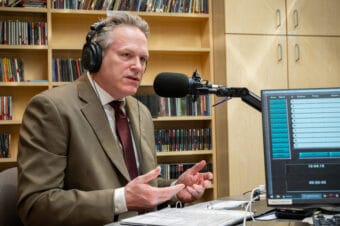
Expert witnesses testified in court Wednesday that traditional tribal values are ingrained in Southeast Native culture. They were testifying in a trial to determine if it is constitutional to display traditional tribal values in Ketchikan schools. Cultural anthropologists and professors took the stand to answer questions about what the values mean to Lingít, Haida and Tsimshian people.
A trial has been ongoing in Ketchikan to determine if displaying the 14 traditional tribal values, developed by area culture leaders, violates the First Amendment. About a third of Ketchikan students are Alaska Native.
Stephen Langdon is a professor of cultural anthropology. He testified that the values all hinge around the idea of respect — central in Southeast Native culture.
“Well, what’s critically important, is that people have to learn to live together, and by understanding others it’s much more successful to be able to live together,” he said.
The idea of “reverence for our creator” is what plaintiffs Justin Breese and Rebecca King say violates the First Amendment’s Establishment Clause. They say that hanging the posters in school common areas without context or a lesson is endorsing the values. They also take issue with how the values are used in a behavior reward program at Ketchikan Charter School. King is a kindergarten teacher at Ketchikan Charter School. The school’s principal, Kayla Livingston, testified during the first day of the trial that “reverence for our creator” has not been selected as a “value of the week” or “value of the month” for the reward program. But, she says there isn’t any rule preventing it.
Langdon said there isn’t a religion or a specific deity worshiped by Lingít, Haida or Tsimshian people.
He told several traditional stories from clans around the region to emphasize how the values are integral in the Native way of life. He referenced stories about the character Raven, which is both creator and trickster — he described the stories as teaching tools.
“The ways in which they are used in teaching is to think about what Raven is doing, and it’s not necessarily in a positive light,” he explained.
But plaintiff Breese pointed out what he believed to be references to creation in Raven stories. Plaintiff Rebecca King spoke at length in court Tuesday.
On the final day, Breese highlighted a website from the Central Council of Tlingit and Haida Indian Tribes of Alaska, which makes a reference to “the Creator” that blessed Indigenous people with the land. The site also has a passage that includes a description of the story “Raven Creates the World” and describes it as a story about “how the Raven created the world.”
But Langdon said that he didn’t think that example was typical.
“That particular use of ‘creation’ tells us how the Raven created the world,” he said. “But that an unusual use of the word creation from the vantage point of Western thought.”
He said that the term doesn’t really translate to English, and Raven stories aren’t creation stories. They’re meant to teach lessons.
“So there is already in place an existence for Raven to interact with, and there’s no deeper story so to speak, in terms of where Raven comes from, or who Raven is supposed to be a part of,” he said.
Rosita Worl is the president of the Sealaska Heritage Institute. She testified that the meaning of the word “creator” got misinterpreted in translation.
“In our culture, reverence for, you know, our creator doesn’t refer to any god or any deity that we worship,” she said. “That’s absolutely not within our culture. Within our culture, creator could refer to multiple beings.”
Worl said that the Southeast Native culture includes a belief that everything has a spirit, even a rock or a table.
She said that the values need to be taught to promote healing from historical wrongs. They are necessary to openly living a traditional way of life.
“We want people to learn about our culture and our values,” Worl said.
In closing arguments, Breese said that the district is teaching the spiritual beliefs of Indigenous people.
“They’re used as a guidepost for behaviors and beliefs required of a good student,” he said. “Recognizing and rewarding students for following the 14 traditional tribal values shows the district is teaching, promoting and endorsing those tribal values instead of teaching about them.”
John Ptacin, the attorney for the school district, argued that not every reference to a creator violates the First Amendment. He said that the values are deeply ingrained in an Indigenous way of life, which has a place in public schools.
“These values take on a meaning which are social and customary for these people,” Ptacin said. “And it has taken on that meaning for the last 12,000 years. Every feature of everyday life — subsistence, ceremonies, and every object that the experts and all the witnesses have shown you. These are the values by which they live.”
Wednesday marked the end of the civil trial in Ketchikan Superior Court. Judge Katherine Lybrand did not give an estimated timeline for her decision but told the courtroom she didn’t expect it to take long.



